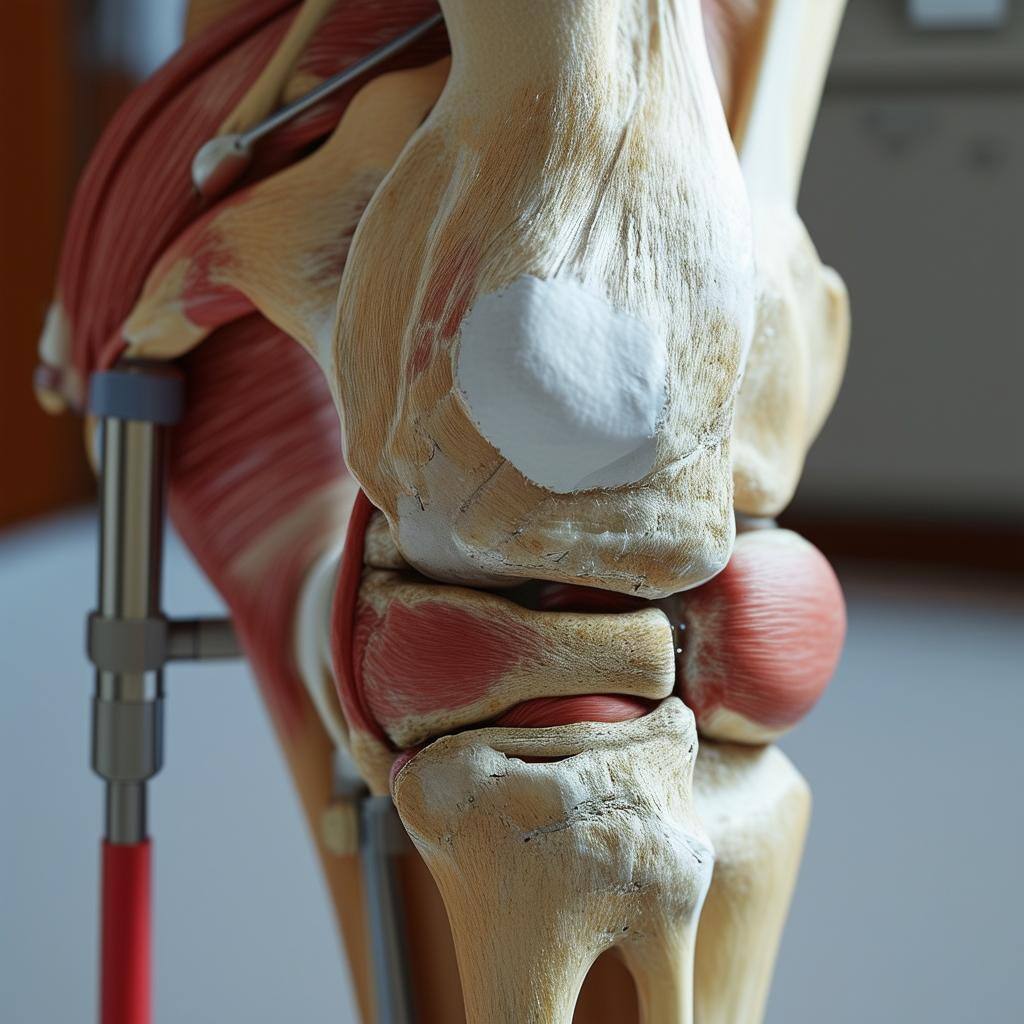.png)
Introduction
Hip replacement surgery, or hip arthroplasty, is a medical procedure where an orthopaedic surgeon strategically removes the damaged parts of the hip joint and replaces them with artificial components. This operation is primarily aimed at individuals who suffer from persistent hip pain and mobility issues due to conditions such as osteoarthritis, rheumatoid arthritis, or traumatic injuries. The main goals of hip replacement are to:
- Alleviate pain that has become unresponsive to other treatments
- Enhance the functional capabilities of the hip joint
- Increase the range of motion and overall mobility
The journey through hip surgery can be intricate, involving careful preparation, the surgical process itself, followed by a structured recovery plan. Various risks and potential complications are also associated with the procedure. To navigate this complex path safely, it's critical to seek guidance from skilled professionals.
Should you consider undergoing hip replacement surgery, consult with a reputable orthopaedic surgeon for personalized advice and expert care. For those looking to connect with top healthcare providers, TopDoc is an excellent resource to book an appointment with a leading doctor in your vicinity. Their platform simplifies the process of finding reputable orthopaedic surgeons who specialize in hip replacements, ensuring that you receive the highest quality care possible.
Understanding Hip Replacement Surgery
Hip replacement surgery may seem intimidating, but learning more about the procedure can help ease your fears. In this section, we will discuss the following:
- The important role of the orthopaedic surgeon in this surgery
- The function and significance of the hip joint
- The different parts involved in a hip replacement
The Role of the Orthopaedic Surgeon
The orthopaedic surgeon plays a crucial role in hip replacement surgery. They have specialized knowledge and skills to:
- Diagnose your condition accurately
- Plan the surgery beforehand
- Perform the actual operation
Their expertise allows them to effectively remove damaged portions of your hip joint and replace them with artificial components. Additionally, they will guide you throughout your recovery process, ensuring that you receive proper post-operative care and rehabilitation.
Function of the Hip Joint
The hip joint is an essential part of our body's structure. It is one of the largest ball-and-socket joints we have, connecting the upper end of our thigh bone (femur) with a portion of our pelvis. Here are its main functions:
- Range of motion: The hip joint enables us to move our legs in various directions.
- Weight-bearing: It supports our body weight, especially when we are standing or walking.
- Balance: The stability provided by this joint helps us maintain equilibrium.
Components of a Hip Replacement
During a hip replacement surgery, damaged portions of your hip joint are replaced with artificial parts that imitate its natural functioning. Here are the key components involved:
- Femoral stem: This component is inserted into your thigh bone and may be made from either metal or ceramic.
- Femoral head: Resembling a ball, it is attached to the top of the femoral stem. Like the stem, it can be made from metal or ceramic.
- Acetabular component: Commonly referred to as the "socket," this part substitutes your damaged socket and is typically made from metal.
- Acetabular liner: It is placed inside the acetabular component and can be made from plastic, ceramic, or metal.
These elements work in harmony to create a smoothly functioning joint that alleviates pain and enhances mobility.
Armed with a better understanding of hip replacement surgery, we can now explore the conditions that might necessitate this procedure. This knowledge will help you make an informed decision about your health care options.
Conditions Requiring Hip Replacement Surgery
Hip replacement surgery becomes a consideration when individuals suffer from chronic joint pain and mobility issues due to underlying conditions affecting the hip joint. The most common ailments that lead to the need for this surgery are:
- Osteoarthritis: This degenerative joint disease is characterized by the breakdown of cartilage, leading to pain and stiffness in the hip.
- Rheumatoid Arthritis: An autoimmune condition that causes inflammation of the synovial membrane, leading to pain and possible deformity of the hip joint.
- Osteonecrosis: Also known as avascular necrosis, this condition occurs when blood flow to a section of bone in the hip is disrupted, causing bone death and joint instability.
- Injuries or Fractures: Severe impacts or falls can cause fractures in the hip that may not heal properly, necessitating surgical intervention.
When Non-Surgical Treatments Fail
Before considering surgery, various non-surgical treatments are typically recommended. These may include:
- Medications: Pain relievers or anti-inflammatory drugs can help reduce pain and swelling.
- Physical Therapy: Exercises to strengthen surrounding muscles and maintain joint flexibility.
- Lifestyle Modifications: Weight loss and activity changes to decrease stress on the hip joint.
- Assistive Devices: Using walking aids like canes or walkers to improve stability and relieve pressure on the hip.
If these interventions do not alleviate symptoms or if joint damage progresses significantly, surgery may be advised. Persistent pain, severe joint damage visible on X-rays, and a substantial impact on quality of life are indicators that it might be time to discuss surgical options with a healthcare provider.
For those interested in learning more about non-surgical interventions before considering surgery:
- Learn about non-surgical treatments for hip pain
Deciding on Surgery
The decision to proceed with hip replacement surgery is a collaborative one, made jointly by patients and their healthcare providers based on several factors:
- Pain Level: Intense or constant pain that interferes with daily activities.
- Mobility Issues: Difficulty walking, climbing stairs, or arising from a seated position.
- Quality of Life: When pain and immobility interfere with work, sleep, or recreational activities.
Early consultation with an orthopaedic surgeon can provide valuable insights into whether surgery is an appropriate option. It's crucial for patients to fully understand their condition and treatment alternatives.
For those weighing the decision for hip replacement surgery:
- Discover when surgery might be right for you
By recognizing the signs early and discussing them with a healthcare professional, individuals can better manage their conditions and plan for potential future treatments, including hip replacement surgery if necessary.
Preparing for and Undergoing Hip Replacement Surgery
Getting ready for hip replacement surgery involves a number of steps designed to enhance the outcome and support a swift recovery. By taking proactive measures, patients can set the stage for a successful procedure and rehabilitation.
Preoperative Measures
- Strengthening exercises: It's essential to focus on building muscle strength, particularly in the core, upper body, and legs. Stronger muscles aid in post-surgery recovery by improving stability and mobility.
- Smoking cessation: Patients who smoke are encouraged to quit or reduce smoking as it can negatively impact healing and increase the risk of complications.
- Weight loss: For those overweight, losing excess pounds can decrease stress on the new hip joint and enhance overall recovery.
Patients should also arrange for post-surgery needs before the operation day. This includes setting up transportation, meal preparation, and ensuring a home environment conducive to recovery.
The Surgical Procedure
Once preoperative preparations are complete, patients will undergo the surgical process:
- Anesthesia administration: Prior to making any incision, anesthesia is given to ensure the patient is comfortable and pain-free during the operation.
- Incision over the hip: A surgeon makes an incision over the hip area to access the damaged joint.
- Removal of damaged bone tissue and cartilage: The orthopaedic surgeon meticulously removes diseased bone and cartilage from the hip joint.
- Insertion of artificial components: New artificial parts are positioned to restore joint function. These components include a metal stem inserted into the femur (thigh bone), a metal or ceramic ball that serves as a new femoral head, and a durable cup that acts as the new socket in the pelvic bone.
The incision is then closed with sutures or staples, marking the end of the surgical procedure.
Recovery and Rehabilitation Strategies
After surgery, attention shifts to recovery and rehabilitation:
- Early mobilization: Often within a day after surgery, patients are encouraged to start moving with assistance. Using walkers or crutches helps in regaining mobility.
- Exercise program: A tailored exercise regimen is vital for strengthening muscles around the new hip joint and improving range of motion.
- Wound care: Proper care of surgical wounds helps prevent infection and promotes healing.
- Follow-up appointments: Regular check-ups with an orthopaedic surgeon ensure that recovery is on track.
By adhering to these guidelines before, during, and after hip replacement surgery, patients can look forward to improved joint function and quality of life.
Potential Risks and Complications
Hip replacement surgery has transformed the lives of many, offering freedom from pain and improved mobility. However, as with any major surgical procedure, certain risks and complications can arise. Understanding these potential issues is essential for patients to make informed decisions and for surgeons to implement strategies to manage them effectively.
Risks Associated with Hip Replacement Surgery
- Dislocation: The new hip joint may become dislocated if the ball comes out of the socket.
- Prevention: Surgeons use precise techniques to ensure proper alignment.
- Management: A brace may be used post-surgery, and in severe cases, a second operation might be necessary.
- Infection: The surgical site or the new joint itself can become infected.
- Prevention: Patients receive antibiotics before and after surgery.
- Management: If an infection occurs, it may require antibiotics or additional surgery to remove infected tissue.
- Blood Vessel or Nerve Injuries: These critical structures can be damaged during surgery.
- Prevention: Careful surgical technique minimizes this risk.
- Management: Physical therapy can assist recovery if nerves are affected; vascular repair might be needed for vessel injuries.
- Deep Vein Thrombosis (DVT): Blood clots can form in the leg veins after surgery.
- Prevention: Blood-thinning medications and compression devices are used.
- Management: Continued use of blood thinners and monitoring for signs of clots.
- Fracture: Bones around the artificial joint may fracture during or after surgery.
- Prevention: Surgeons plan carefully to avoid undue pressure on bones.
- Management: Some fractures are treated with rest or bracing, while others may need surgical repair.
- Leg Length Differences: One leg may end up slightly longer or shorter post-surgery.
- Prevention: Measuring during surgery for accurate leg length.
- Management: Shoe lifts can correct minor discrepancies; revision surgery is rare but possible for significant differences.
- Implant Failure: Over time, artificial joints may wear out or loosen.
- Prevention: Use of high-quality implants and proper surgical technique.
- Management: Regular follow-ups help detect early signs of wear; revision surgery might be needed if failure occurs.
Long-term Considerations for Artificial Hip Joints
Individuals with hip replacements should consider several long-term aspects:
- Activity Modifications: Certain high-impact activities might need to be avoided to prolong the life of the implant.
- Ongoing Surveillance: Regular check-ups allow for early detection of any issues with the artificial joint.
- Awareness: Patients should remain aware of their body's signals, reporting any changes such as increased pain or decreased function immediately.
Educating patients on these risks and their management helps prepare them for a successful journey through hip replacement surgery. While risks cannot be completely eliminated, their impact can often be minimized through meticulous surgical technique, careful patient monitoring, and a thorough rehabilitation program. With these measures in place, most patients can look forward to improved quality of life post-surgery.
Seeking Professional Guidance for Hip Replacement Surgery
When faced with the decision of undergoing hip replacement surgery, seeking professional advice cannot be overstated. A knowledgeable healthcare provider offers a wealth of information, including:
1. Assessment of Your Condition
An expert will evaluate the severity of your hip joint issues and discuss whether hip replacement is the best course of action.
2. Customized Treatment Plan
Based on your unique health profile, they can create a tailored plan that addresses your specific needs and concerns.
3. Explanation of Procedure Details
Gain a clear understanding of what the surgery entails, the type of implants used, and what to expect during recovery.
4. Risk Management
Professionals guide you through potential risks and how to minimize them.
5. Post-Surgery Expectations
Understand the rehabilitation process and long-term care for your artificial hip joint.
Selecting the right healthcare provider is pivotal. Look for surgeons who have extensive experience in performing hip replacements and can provide patient testimonials or success rates.
Remember, each patient's journey to regaining mobility is unique. The guidance you receive from a dedicated orthopaedic surgeon will help ensure that you are making an informed decision about hip replacement surgery, tailored to your personal health circumstances.
Conclusion
Hip replacement surgery is an important treatment option for people with severe hip joint damage or disease. It can help relieve pain and improve mobility. During the procedure, the damaged part of the hip is replaced with an artificial hip joint that functions like a natural hip.
While hip replacement surgery is complex and requires skilled surgeons and careful post-operative care, its potential risks such as infection, dislocation, or early wear of the artificial joint can be managed with proper medical guidance.
Why it's important to learn more about hip replacement surgery
It's essential to educate yourself about hip replacement surgery so you can make informed decisions about your health:
- Understand the procedure: Learn about how the surgery works and what happens during the operation.
- Prepare for surgery: Find out what you need to do before the procedure to ensure a smooth experience.
- Recover effectively: Discover rehabilitation strategies that can help you regain strength and mobility after surgery.
- Know when it's necessary: Familiarize yourself with the conditions that may require hip replacement surgery.
By gaining this knowledge, you'll be better equipped to discuss treatment options with your healthcare provider and actively participate in your own care.
Trusted resources for reliable information
To learn more about hip replacement surgery, you can visit topdoc.com. This website offers trustworthy information and resources on various medical topics, including hip replacements.
Importance of personalized guidance
It's important to remember that every patient is unique, and what works for one person may not work for another. That's why personalized guidance from healthcare professionals specializing in hip replacement surgery is crucial for optimal results.
If you're considering hip replacement surgery or have questions about the procedure, you can schedule a consultation with trusted orthopaedic surgeons who specialize in this area on topdoc.com. They will understand your specific needs and provide tailored treatment solutions based on your condition.
FAQs (Frequently Asked Questions)
What is hip replacement surgery?
Hip replacement surgery is a common procedure that aims to relieve pain and restore function in the hip joint. It involves replacing diseased parts of the hip joint with artificial components.
What are the common conditions that may necessitate hip replacement surgery?
Common underlying conditions that may require hip replacement surgery include osteoarthritis, rheumatoid arthritis, osteonecrosis, and injuries or fractures.
What are the important steps to take before undergoing hip replacement surgery?
Important steps to take before the surgery include preoperative exercises, lifestyle modifications such as smoking cessation and weight loss, and consulting with a reputable orthopaedic surgeon for expert advice.
What are the potential risks associated with hip replacement surgery?
Potential risks include dislocation, infection, blood vessel or nerve injuries, deep vein thrombosis (DVT), fracture, leg length differences, and implant failure. Long-term considerations for individuals with an artificial hip joint are also discussed.
Why is it important to seek professional guidance for hip replacement surgery?
It is crucial to consult with a knowledgeable healthcare provider when considering hip replacement surgery in order to receive personalized guidance and make informed decisions about the procedure.
Where can I find trusted orthopaedic surgeons specializing in hip replacement surgery?
You can find trusted orthopaedic surgeons who specialize in hip replacement surgery and schedule a consultation for personalized guidance by visiting [insert internal link to topdoc.com].



Comments (0)